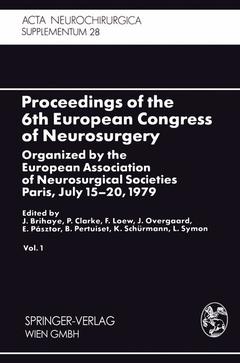Proceedings of the 6th European Congress of Neurosurgery, Softcover reprint of the original 1st ed. 1979 Organized by the European Association of Neurosurgical Societies Paris, July 15–20, 1979. Vol. 1 Acta Neurochirurgica Supplement Series, Vol. 28
Langue : Anglais
Coordonnateurs : Brihaye J., Clarke P. R. R., Loew F., Overgaard J., Pasztor E., Pertuiset B., Schürmann K., Symon L.

Organized by the European Association of Neurosurgical Societies, Paris, July 15-20, 1979
Prognostic Assessment of Coma in Relation to Age.- Adding up the Glasgow Coma Score.- Protocol for Reception, Management, and Assessment of Head Injuries.- Eye Movements as a Prognostic Factor.- The Clinical Criteria in Gravity Assessment of Acute Head Injuries Associated With Coma.- Combined Clinical and EEG Examinations for Assessment of Severity of Acute Head Injuries.- Using the Spectral Analysis of the EEG for Prognosis of Severe Brain Injuries in the First Post-Traumatic Week.- Prognostic Aspects of Electroclinical and Neuroendocrine Data in Severe Brain Injury.- Early Prognosis After Severe Human Head Injury Utilizing Multimodality Evoked Potentials.- Heart Rate Studies in Association With Electroencephalography (EEG) as a Means of Assessing the Progress of Head Injuries.- Prognostic Information From EEG and ICP Monitoring After Severe Closed Head Injuries in the Early Post-Traumatic Phase.- Symptoms of Temporal Lobe Contusions in the Early Period Post-Trauma.- Significance of Intracranial Pressure and Neurological Deficit as Prognostic Factors in Acute Severe Brain Lesions.- Prognostic Value of the Intracranial Pressure Levels During the Acute Phase of Severe Head Injuries.- The Prognostic Value of Intracranial Pressure Monitoring After Severe Head Injuries.- Prognostic Signs During Continuous Monitoring of the Ventricular Fluid Pressure in Patients With Severe Brain Injury.- CT, EEG, and ICP Recordings During Intensive Care of Acute Head Injuries.- CT Scan, ICP, and Early Neurological Evaluation in the Prognosis of Severe Head Injury.- Post-Traumatic Acute Rise of ICP Related to Subclinical Epileptic Seizures.- Serum Myelin Basic Protein, Clinical Responsiveness, and Outcome of Severe Head Injury.- The Significance of Cerebral and Systemic Disseminated Intravascular Coagulation in Early Prognosis of Brain Injury.- Disseminated Intravascular Coagulation Related to Outcome in Head Injury.- Prognostic Significance of the Changes in the Carbohydrate Metabolism in Severe Head Injury.- CKBB-Isoenzymes as a Sign of Cerebral Injury.- Disturbances of the Carbohydrate Metabolism in Acute Head Trauma.- The Prognostic Value of Osmolality Within the First Week of Sustaining Head Injury.- Post-Traumatic Amnesia, Post-Concussional Symptoms, and Accident Neurosis.- Burdens Imposed on the Relatives of Those With Severe Brain Damage Due to Injury.- The Nature of Physical, Mental and Social Deficits Contributing to the Categories of Good Recovery, Moderate and Severe Disability in the Glasgow Global Outcome Scale.- Long-Term Prognosis After Severe Head Injury.- Factors Determining Prognosis in Acute Subdural Haematoma.- Factors Influencing the Outcome of Coma in Severely Injured Patients.- Age and Outcome of Severe Head Injury.- Early Prognosis of Severe Head Injuries in Children.- Prognosis in Diffuse Injury.- Prognosis in Patients With Severe Head Injury.- Prognostic Factors in Acute Head Injuries—Brain Stem Contusion During the First Week.- Prognosis of the Individual Patient With Severe Head Injury.- Predicting the Outcome of Individual Patients in the First Week After Severe Head Injury.- Head Injury Prognosis: Calculations From Clinical Data.- Predicting Outcome After Severe Head Injury—A Computer-Assisted Analysis of Neurological Symptoms and Laboratory Values.- Risk Factors in Severe Head Injury.- The Prediction of Outcome of Patients Admitted Following Head Injury in Coma With Bilateral Fixed Pupils.- Forecasting Peculiarities of Intracerebral Pressure and Local Cerebral Blood Flow Data and Methods of Outcome Forecasting in theEarly Postoperative Period.- Sleep Alterations During Post-Traumatic Coma as a Possible Predictor of Cognitive Defects.- Assessment of Outcome Following Large Decompressive Craniectomy in Management of Serious Cerebral Contusion.- Outcome of Acute Subdural Haematoma Following Decompressive Hemicraniectomy.- Early Surgical Treatment of Traumatic Intracranial Haematomas and Laceration Foci as the Main Factor for Favourable Prognosis.- Local CBF in the Laceration Focus in Patients With Craniocerebral Trauma.- Brain Injuries—Causes of Death, and Life Expectancy.- On Comparing Series of Head Injured Patients.- Effect of Therapy on Prognosis of Cerebral Contusions.- The Assessment of the Efficacy of Different Therapies for Severe Head Injuries.- Phenomena Associated With Focal Ischaemia in the Central Nervous System.- Experimental Cerebral Hypoxia and Ischaemia in Cats.- Experimental Middle Cerebral Artery Embolization and Embolectomy.- Pentothal Protection for Delay Cerebral Revascularization.- Techniques of End-To-Side Anastomosis—Experimental Evaluation and Clinical Findings.- A New Technique for End-To-Side Anastomosis Between Small Arteries.- A Scanning Electron Microscopic (SEM) Study of the Re-Endothelialization of the Carotid End-To-Side Anastomosis in the Rat.- Scanning Electron Microscopy of the Endothelial Surface of Small Diameter Vein Grafts in Rats Treated With Heparin.- Venous Patch in Arteries of 1 mm External Diameter.- Application of Magnetobiological Effects in Restorative Cerebral Angiosurgery.- Microvascular Repair With Neodymium-YAG Laser.- Surgical Possibilities in the Third Portion of the Vertebral Artery (Above C2).- Assessment of Regional Cerebral Blood Flow Using the XE-133 Inhalation Method in Patients Undergoing EIAB Surgery.- CorticalArterial Pressure in Extra-Intracranial Anastomosis.- Animal Experiments With Doppler Flow Transducers.- The Role of Anastomoses in Brain Circulation.- Cerebral Revascularization With Extra-Intracranial Anastomoses for Vascular Lesions of Traumatic Malformative, and Tumours Origin.- Prevention of Brain Stem Stroke by Microvascular Anastomosis.- The Importance of the Early Diagnosis of Preocclusive Carotid Artery Lesions.- Microsurgical Approach to Bilateral Carotid Artery Occlusion.- Tandem Lesions of the Internal Carotid Arteries and Their Management.- Multiple Angiographic Studies and Tri-Dimensional Assessment of Regional Cerebral Perfusion on Patients Treated by EC-IC Bypass.- ExtraIntracranial Cerebral Anastomosis Operation in Acute Ischaemia as an Emergency.- EICA in Transient Ischaemic Attacks and Neurological Deficits.- Extra-Intracranial Anastomosis in Patients With Completed Strokes.- Effect of Extra-Intracranial Arterial Bypass (EIAB) on Cerebral Circulation and EEG.- Advantage of Using Hyperbaric Oxygenation (HO) in Combination With Extra-Intracranial Arterial Bypass (EIAB) in the Treatment of Completed Stroke.- Six Hundred Endovascular Neurosurgical Procedures in Vascular Pathology.- Endovascular Method of Excluding From the Circulation Saccular Cerebral Arterial Aneurysms, Leaving Intact Vessels Patient.
Date de parution : 11-2013
Ouvrage de 315 p.
15.5x23.5 cm
Thème de Proceedings of the 6th European Congress of Neurosurgery :
Mots-clés :
© 2024 LAVOISIER S.A.S.
